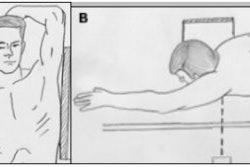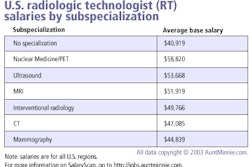SALT LAKE CITY - Devising a radiation safety program can be a daunting task in itself, but creating a plan that is meaningful to both imaging and non-imaging specialists is even harder. One rule of thumb: Don’t assume that all healthcare professionals at your institution are up-to-date on the basics of radiation exposure.
That was one of the take-home messages from a Society of Interventional Radiology (SIR) poster presentation on the importance of radiation safety education in the interventional procedure suite.
Dr. W. Perry Arnold from Dialysis Access Specialists in Baltimore and co-authors assessed radiation safety issues at eight freestanding dedicated hemodialysis vascular access centers. Non-radiologists, such as interventional nephrologists, performed many of the interventional procedures at these centers. Arnold’s co-authors are from RMS Lifeline in McGaw Park, IL, and Ohio State University in Columbus.
"(We wanted to) investigate the impact of a new radiation safety program on radiation safety knowledge," they wrote. "In addition, the purpose of the project was also to reassure staff that current radiation protection processes and policies were effective."
A needs assessment survey was developed to deal with such issues as current and past dosimetry readings; badging and shielding use; machine placement; and room shielding. The primary safety points were lead-lined walls, along with standard 0.5-mm aprons, thyroid collars, and ring badges. Facility radiation surveys were performed twice annually. The staff’s knowledge of safety issue was tested before and after implementation of the program.
Prior to training, the staff’s test scores on radiation safety issues ranged from 40-100 (mean 78). After training, the test scores jumped to 78-100, with a mean of 90. The caseloads for the non-radiologist interventionalists during the test period were 6.2 cases per day with an average fluoroscopy time of 4.1 minutes. Testing dosimetry badges were placed at 43 cm, 56 cm, and 60 cm away from the primary beam, with no recordable reading of scatter radiation.
The principal educational tool was a manual developed by Arnold and Dr. Gerald Beathard, Ph.D., from RMS Lifeline. On a technical level, a thorough manual should review, in detail, the basic elements of the fluoroscopy suite (parts of the portable C-arm; monitor console), as well as the factors that influence radiation dosage (kVp, mAs, collimation, filtration, etc.).
The training manual is an opportunity to break bad habits or debunk popular myths regarding radiation issues. The authors emphasized that personal dosimetry monitoring is a matter of law and not individual preference. Also, film badges or rings should not be taken outside the facility as they are sensitive to a wide range of radiation sources, Arnold and Beathard explained.
However, when it comes to pregnancy, personal choice does rule: A pregnant patient or worker maintains the right to declare or not declare a pregnancy. Also, a pregnant staff member can declare pregnancy without medical proof.
Casually swapping or sharing other safety equipment, such as lead aprons or eye shields, may do more harm than good: An apron, for example, should fit properly because if the shoulders are too wide, the apron can slip off and cause radiation exposure.
Implementing the safety training program also helped the centers change the presumptions of non-imaging interventionalists, who skipped out on safety precautions, such as lead glasses, because they determined the radiation dose was too low.
Finally, the authors drove home the point that the best way to keep exposure to a minimum is by having a minimum number of people in the fluoroscopy suite.
"A dedicated training program on radiation safety principles and procedures, along with local regulations, will significantly improve staff knowledge," they concluded. "It’s important in the interventional suite…particularly in light of non-radiologists performing procedures."
By Shalmali Pal
AuntMinnie.com staff writer
March 31, 2003
Related Reading
Some radiologic technologists at increased risk for melanoma, March 4, 2003
U.S. to evaluate whether x-rays should be labeled carcinogens, February 18, 2003
Studies cast doubt on low-level radiation dangers, January 30, 2003
Breast cancer mortality high in x-ray techs who worked before 1950, June 20, 2002
ARRT study assesses technologists' cancer risk, May 3, 2002
Copyright © 2003 AuntMinnie.com



















